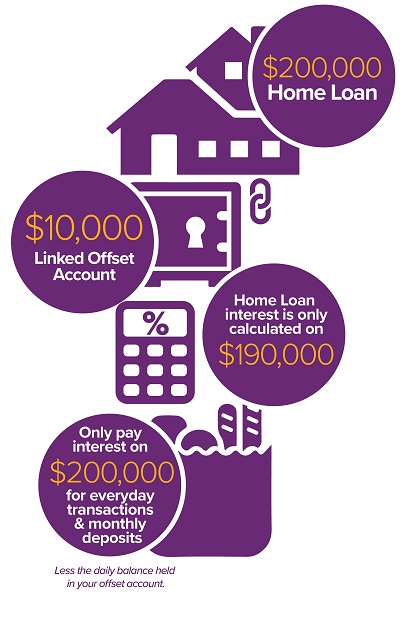If you’re planning to buy your first home or investment property, the chances are you’re also trying to get to grips with a number of home loan features. Two of the most popular features are loan redraw facilities and offset accounts. Both can take years off your loan term and potentially save you thousands of dollars in interest at the same time.
But what exactly is a redraw facility and what’s an offset account? And what’s the difference between the two? Below we cover the pros and cons of each feature, and why your own financial goals and personal circumstances matter when deciding what’s right for you.
What’s a redraw facility?
A redraw facility is a standard feature on most variable home loans. Basically, it allows you to make additional payments into your home loan whenever you like*.
These additional payments reduce your principal and therefore the amount of interest you’re paying on your loan.
You still need to make your agreed monthly repayments, but if you have some extra cash available, depositing this into a redraw facility is a great way to help pay off your principal quicker and save money on interest charges.
Although many homeowners use a redraw facility as an excellent way to save, you can redraw or access these additional payments if you need them.
Bear in mind that some home loans with redraw facilities will charge withdrawal fees and access to your funds may not be immediate.
What’s an offset account?
An offset account is a transaction account linked to your home loan, and it works just like an everyday bank account. You can deposit your salary into the account and use a debit or eftpos card to make purchases whenever you need to.
You can also use the account to pay household bills such as utilities and insurance premiums.
An offset account 'offsets' your home loan balance daily, meaning you’re only paying interest on the difference between your principal loan and the balance in your offset account.
Here's an example of an offset account scenario:
Let's say you have a home loan of $200,000 and set up a linked offset account1 with an initial balance of $10,000. In this case, your home loan interest is only calculated on the difference which is now $190,000.
Even though your offset account balance will fluctuate with monthly deposits such as your salary and your everyday transactions such as groceries, you only ever pay interest on the $200,000, less the daily balance held in your offset account.
Is a redraw facility better than an offset account: how to they each weigh up for you?
Like any big financial decision, understanding your financial goals and looking at the bigger picture is crucial. If you’re focused on repaying your home loan principal as quickly as you can, then a redraw facility may be an option.
But if you would like to reduce the amount of interest owing over the lifetime of your home loan and still have instant access to your cash, then an offset account may be another choice.

Weighing up the pros and cons.
As you can see from the examples, redraw facilities and offset accounts are in some ways similar. And both can potentially save you thousands of dollars in interest and reduce the life of your home loan. But there are pros and cons of both features:

Pros of a redraw facility.
- Paying down your principal – A redraw facility is a good option if you’re able to make extra repayments and are focused on paying off your mortgage principal quicker.
- Occasional lump sum access - Redraw facilities are a great feature if you only need access to your funds now and again. Your money is not locked away and you can still redraw for any sudden or planned expenses, such as home renovations or a new car.
- A great place to save – By depositing savings* into your redraw account, you won’t earn interest on your savings but you will reduce the amount of interest you pay on your home loan.
Pros of an offset account.
- Easy access - Like an everyday bank account, access to the cash in your offset account is instant. You can deposit and withdraw your money as often as you like.
- Incremental savings - Offset accounts are a great alternative to redraw facilities if you can’t afford to make additional or lump sum repayments. That’s because you’re still able to reduce your interest repayments based on your account deposits and direct debits.
- Tax incentives - An offset account is a great place to deposit any other sources of income you have, such as investment profits. Because the money in your offset account doesn’t gain interest, it’s not considered taxable income. If you’re an investor however, there may be other tax implications so it’s always best to check.
Important note: Contact the Australian Taxation Office for accurate and up to date tax advice to always make sure you’re making well-informed home finance decisions.

Cons of a redraw facility.
- Accessing your money - Access to your money is not always immediate~ and you may need to apply to your lender to withdraw your required amount. The money available for redraw is only the extra repayments you’ve made on your home loan.
- Withdrawal restrictions - Some home loans with redraw facilities may have a minimum withdrawal amount and additional fees+, including a fee every time you want to access your money. Having said that, more banks now offer free online access to redraw facilities on certain mortgages, such as our own Special Low Rate Variable Home Loan.
- Variable rate home loans only - If you’re looking for a fixed rate home loan, you may struggle to find one that comes with a redraw facility.
Cons of an offset account.
- Higher fees - With an offset account, you may pay higher fees and interest rates in return for the flexibility you get. So, you may need to deposit a larger amount of money to make this facility worth your while.
- A need for discipline - Instant access to your cash may be a disadvantage if you’re likely to keep dipping into your account.
- Variable rate home loans only - Offset accounts are generally not offered with fixed rate home loans.
Redraw or offset? Key questions to ask.
- Is your primary goal to reduce your interest payments or pay off your principal loan amount as quickly as possible? Offset accounts are ideal if you want to minimise your interest payments without necessarily reducing your principal loan amount in the long term.
- Can you afford to make extra payments off your mortgage? If the answer is yes, then a mortgage drawdown facility might be your best option.
- Do you already have savings or investment profits you could transfer into your offset account? The larger the balance in your offset account, the greater the financial benefits are to you over the lifetime of your loan.
- Do you need daily access to your money? If the answer is yes, then an offset account is the way to go.
As you can see, both loan redraw facilities and offset accounts have their own benefits and drawbacks. The good news is that we offer both features on several of our variable home loans. To help you decide which feature is right for you, our home loan specialists are on hand to run you through each home loan option. Make an appointment today.
Helping hand for first home buyers.
At Beyond Bank, we understand buying a home or investment property can be daunting, especially for first home buyers. That’s why we’ve put together our first home buyer resources designed to help you. You’ll also find some quick links to information on other common home loan terms such as LVR, LMI and stamp duty.
And, if you’re interested in some practical home buying advice from our very own community, grab a cuppa and download our home buying tips e-book now.
*Up to $25,000 per year on each fixed rate loan held within the package without fee or penalty. Additional repayments over $25,000 per year to a fixed rate term will result in a break cost being payable.
+Minimum redraw amount for variable home loans is $500. An amount equivalent to the next scheduled repayment for the loan cannot be redrawn from the in-advance amount.
~Transfers made on Internet Banking and Mobile Banking can take up to 24 hours to process. For immediate transfers please call us on 13 25 85 or visit a branch.
1 A minimum $500 balance must be retained in the Offset Account to receive the benefit.
Lending criteria apply to all loans, for full terms, conditions, fees and charges, please review our Financial Services Guide, Product Guide and Fees and Charges Guide. These guides are available here and will be provided at the time of acquiring the product or by contacting 13 25 85.
This information has been provided without taking into account your objectives, financial situation or needs. Before acting on this information, you should consider its appropriateness, having regard to your objectives, financial situation and needs. All loans are provided by Beyond Bank Australia Limited, 100 Waymouth Street, Adelaide, SA 5000 ABN 15 087 651 143 AFSL/Australian Credit Licence 237856. © 2019.
